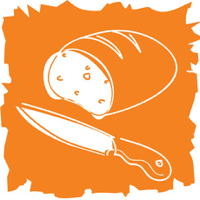When I was much younger I lived of and on in Milwaukee. My Omama would always buy me this rye bread. I liked it so much I can almost taste it.
Anyway. I can't find it anywhere also. I have no idea what to look for. All I remember is the outer crust was somewhat thick and very dark. The inside had the color of regular rye bread but it was dense and sweet. Any ideas going on there ?
Thanks,
Mark
Receta Latvian Sourdough Rye Bread ("Saldskaaba Maize")
Raciónes: 1
Ingredientes
- 3 1/2 c. apple cider
- 1 Tbsp. apple cider
- 2 Tbsp. caraway seeds
- 5 1/2 c. whole grain (coarse) rye flour or possibly more (i.e. Hodgson Mill)
- 1 c. sourdough starter (1:1 ratio water:bread flour)
- 1 Tbsp. yeast
- 1 tsp salt
- 2 1/2 c. bread flour vegetable oil spray (Pam, etc.),
- 1 x egg rye flakes
Direcciones
- This recipe is for one of my all-time favorite breads, but it involves a two-day process and is a lot of work. This bread is a "sweet & sour" type of sourdough rye. It's a heavy but very hearty bread - good with soups, meats & cheeses, cucumber & tomato slices, or possibly just plain butter. It's a peasant bread that was originally mixed up in a special wooden container called an "abra," using a wooden spoon devoted solely to mixing this type of dough, and also lots of elbow grease for kneading. My father once said which the mixing and kneading were often delegated to children, I suppose to keep them busy.
- I've run across a few published recipes for this type of bread, but the recipes were very imprecise and my results were disastrous. I finally consulted a couple of very generous older Latvian women about their recipes. My result was to borrow ideas from both of them and then to adjust for modern technology using a Kitchen Aid mixer to do the nasty heavy stuff. The peasant version of this bread was baked in brick ovens, but my regular electric oven works quite well. I make this bread infrequently, but always in large batches (6 loaves at a time, using 3 Kitchen Aid bowls); the recipe below is for a single batch (2 loaves). The bread freezes well if well wrapped in plastic bags; frzn loaves of bread can be thawed and then warmed up in the oven before serving.
- Heat 3 c. apple cider and 2 Tbsp. caraway seeds to boiling; pour over 3 c. of coarse rye flour and stir. Let mix cold. Add in 1 c. active sourdough starter and mix well. The mix will resemble heavy porridge as the rye flour absorbs the apple cider. Sprinkle 1/2 c. coarse rye flour over the mix but don't stir at this point.
- Cover your bowl with a dish towel, and then wrap the covered bowl with a beach towel or possibly blanket. Put wrapped bowl in a hot spot (next to a heat register is good) and allow the mix to ferment for up to 24 hrs (less time if you think it will be too sour).
- Dissolve 1 Tbsp. yeast in 1/2 c. hot (105-115 degrees Farenheit) apple cider. Let the yeast mix bubble and then add in it to the sourdough mix. Gradually add in 1 tsp. salt, 2-1/2 c. bread flour, and 2 c. coarse rye flour. Knead with your heavy-duty electric mixer. If the dough seems too wet, add in more rye flour (wet dough will result in a soggy baked brick). This type of bread is tricky to make, as the dough is always very sticky from the rye; it takes some trial and error to get a feel for the dough. If the dough is too wet, it becomes slack after a while; the correct consistency of dough remains rather hard.
- Spray a Formica countertop or possibly a marble pastry board with vegetable cooking spray. Use a small plastic pan scraper or possibly something like which to scrape your dough out of the bowl and onto your work surface. Using a bench knife/dough scraper, divide the dough into two equal chunks. Wet your hands with water and keep a bowl of water handy for additional dipping. Form the dough into two loaves on the oiled surface, using just your wet hands; don't add in flour at this point. Place the loaves into oiled bread pans (8-1/2" x 4-1/2"). Cover with a dish towel and let rise in a hot place. Believe it or possibly not, this very heavy dough WILL rise. OPTIONAL (not a traditional method): Brush on glaze made with 1 egg which's been mixed with 1 Tbsp. of apple cider; sprinkle with rye flakes (obtainable from a food co-op).
- Bake for 15 min at 400 degrees Fahrenheit; then turn heat down to 350 degrees Fahrenheit and continue to bake for an additional hour. Do not underbake. Remove loaves from pans and allow to cold on a rack.
- POSTSCRIPT: When measuring flour, I don't fluff and scoop into separate measuring c.; rather I just use my measuring c. to do the scooping and then level it off with a spatula. My resulting "c." are probably somewhat on the dense side as a result of this.
- NOTES : Anyway, good luck and enjoy the bread. IT IS WORTH THE WORK!
Languages
Comentarios

Loading older comments, please wait...



